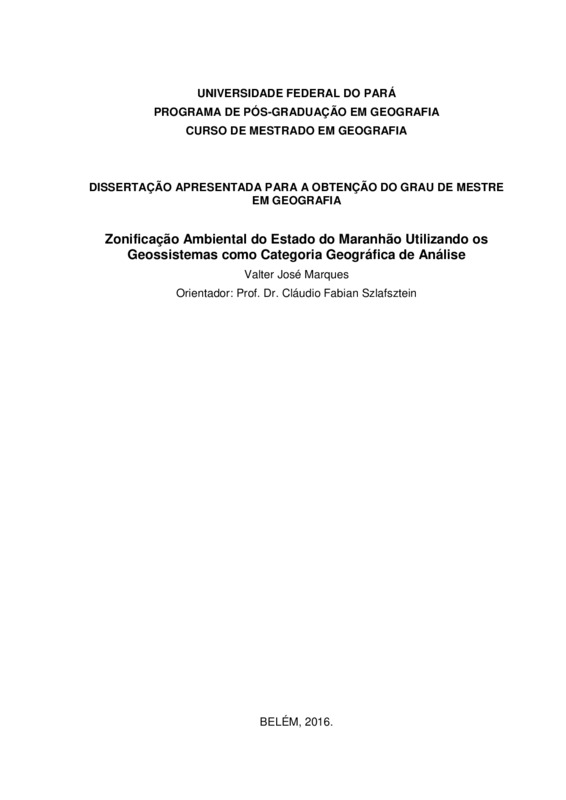-
Título
-
Zonificação Ambiental do Estado do Maranhão Utilizando os Geossistemas como Categoria Geográfica de Análise
-
lista de autores
-
VALTER JOSE MARQUES
-
Resumo
-
Com 331.937 km 2 o Estado do Maranhão situa-se na transição entre os biomas da
caatinga a leste, para cerrado e matas de babaçu e finalmente florestas ombrófilas
densas a oeste. Na dimensão latitudinal distinguem-se dois grandes
compartimentos: costeiro e continental, separados por um degrau tectônico E-
W/NW. A essa diversidade geográfica correspondem nuanças geológicas,
geomorfológicas, climáticas e pedológicas, que se traduzem por diferentes
ocupações e usos do espaço geográfico. Até aqui, o planejamento territorial tem se
apoiado na divisão político-administrativa e nos usos reais ou potenciais. As
abordagens ambientais baseiam-se no rebatimento temático sobre a dimensão
ecológica e/ou os compartimentos geomorfológicos. No presente estudo optou-se
pela zonificação ambiental sob a perspectiva sistêmica do método Geossistema-
Território-Paisagem, agregando-se os vieses físico, biótico e social-cultural. A
discriminação dos geossistemas e a busca por suas origens permitiu que se
entendesse o quão eles estão conectados à evolução tectônica da plataforma
continental brasileira, decorrente da deriva continental que separou Brasil de África.
Na escala regional/local os 12 geossistemas mapeados se comportam como
“ladrilhos” crustais movimentados por forças da dinâmica interna da Terra. O
delineamento das unidades, geossistêmicas mapeadas é coerente com o das
anomalias gravimétricas e também acompanham a compartimentação das bacias
hidrográficas. Os diversos temas dos meios físico e biótico encontram-se refletidos
nas unidades geossistêmicas o que comprova a sua natureza sistêmica. Da mesma
forma que a diversidade de usos, ocupações e os aspectos culturais. Em conclusão,
a zonificação ambiental com base em geossistemas viabiliza a gestão territorial
simultaneamente através de seus vieses ambiental, hídrico, ecológico e econômico.
A retrospectiva das territorialidades, implantadas ao longo da história do Maranhão,
corroborou que as referidas representaram uma força-motriz à produção de matérias
primas para mercados globais. Tal fato, associado a políticas aleatórias e
imediatistas, resultou na exclusão social de significativas porções populacionais. A
formulação de cenários alternativos, sob a ótica do desenvolvimento sustentável,
propugna por novas políticas baseadas numa visão territorial geossistêmica e que se
priorizem as inovações tecnológicas, com respeito à matriz energética,
infraestrutura, verticalização das cadeias produtivas locais e a adoção de políticas
que preservem ecossistemas e conservem os serviços ambientais.
-
Abstract
-
The state of Maranhão possesses 331.937 square kilometers; coated to the west by
dense ombrophylous forests and to the east for cerrado and forests of babaçu, in
transition for the biome caatinga. In the latitudinal dimension, are distinguished two
large bays: coastal and continental, separated by a structural and step-W/NW. To
this geographical diversity correspond geological, geomorphological, climatic and soil
nuances, which result in different occupations and uses of geographic space. Even
here, the territorial planning has supported in the political-administrative division and
in actual or potential uses of the natural environment. The ambient boardings are
based on the thematic striking on the ecological dimension and/or on the
geomorphological compartments. In the present study, it was opted to the
zonification under the systemic perspective of the geossystem-territory-landscape
method, wich embraces the the biases physical, biotic and sociocultural. The
discrimination of geossystems and the search for its origins had allowed to greater
clarification on the connection and tectonic evolution of the Brazilian continental
platform, on account of the continental drift, that separated Brazil from Africa. In the
local regional/locale/, the 12 geossystems mapped behave as “crustals paving-tiles”,
put into motion for forces of the internal dynamics of the Earth. The delineation of the
geossystemic units is consonante with the one of the gravimetrical anomalies and the
limits of the hydrographic basins. Biotic and physical themes are reflected on the
geossystemic units, as the uses of land, and cultural aspects are, showing their
integrated nature. Of this form, the zonification, on the basis of geossystems, makes
possible the territorial management, through its ambiental, hydric, ecological and
economic biases. As retrospective of the territorialities, implanted throughout the
history of the Maranhão, the fact ascends of that they had as force-motor the
production of substances cousins for global markets. These contingencies,
associates with the non- inclusive politics involving populations on the global
businesses resulted in significant social exclusion. Finally, an assay directed to the
formularization of alternative scenes, under the optics of the sustainable
development, advocates for new aimings marked out with buoys in complete a
territorial vision, that over all prioritizes the technological quality of the human
resources and innovations with respect to the energy matrix, infrastructure,
verticalization of local productive chains and in the adoption of ambient politics
regarding nature conservation and preservation of environmental services.
-
Palavras Chave
-
GEOSSISTEMA
-
ZONIFICAÇĂO
-
CENÁRIOS
-
MARANHĂO
-
ZONEAMENTO
-
Key Words
-
ANALYTICAL TOOLS
-
GEOSYTEM
-
ZONING
-
SCENNARIOS
-
MARANHAO
-
Tipo
-
Dissertação de Mestrado
-
Universidade
-
UNIVERSIDADE FEDERAL DO PARÁ
-
Local
-
Belém - PA
-
Data
-
2016
-
Páginas
-
132
-
Localização
-
BIBLIOTECA CENTRAL UFPA
-
Orientador
-
CLAUDIO FABIAN SZLAFSZTEIN
-
Programa
-
GEOGRAFIA
-
Sigla Universidade
-
UFPA
-
Área de Concentração
-
ORGANIZACAO E GESTĂO DO TERRITÓRIO
-
Língua
-
Português
-
email
-
VALTER.MARQUES@CPRM.GOV.BR

